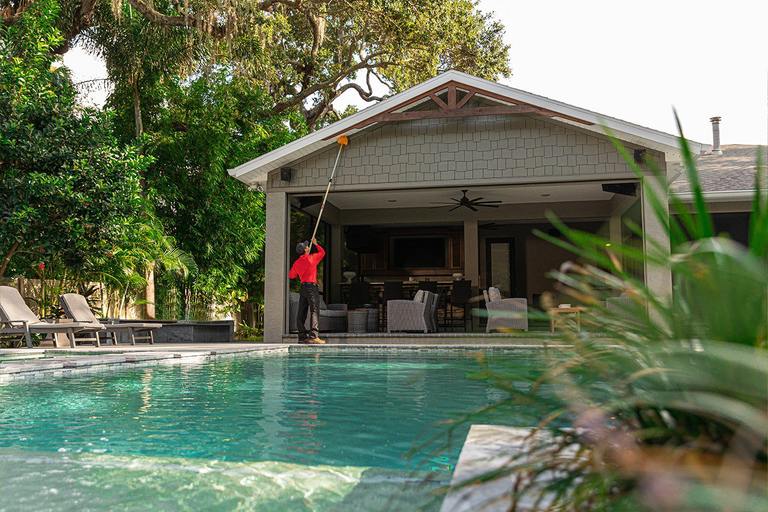What's Stinging You? Here's our Guide to Types of Hornets and Wasps
Published: January 23, 2024

If you've ever encountered a buzzing, stinging insect, you know how important it is to identify the type of creature you're dealing with. Understanding the differences between various types of hornets and wasps can help you take appropriate action and ensure your safety. In this guide, All U Need Pest will walk you through some common varieties of hornets and wasps , providing physical descriptions and key characteristics to help you distinguish one from another.
Paper Wasps
Paper wasps are slender insects that typically measure around 1 inch in length. They have long bodies with slender bodies, and their wings are folded lengthwise when at rest. These wasps are known for building open-celled paper-like nests that hang from eaves, tree branches, or other protected areas. Many of these are red wasps with striped abdomens.
Potter Wasps
Potter wasps are similar in appearance to paper wasps but have distinct markings on their bodies. They are typically black or brown with yellow or white patterns on their abdomen. Potter wasps construct small mud nests that resemble miniature pots or vases.
Great Black Wasps
Great black wasps are large insects that can measure up to 2 inches in length. They have shiny black bodies with smoky-black wings. Despite their intimidating size, these solitary wasp species are generally not aggressive towards humans unless provoked.
Mud Dauber Wasps
Mud dauber wasps, also called thread waisted wasps are slender with elongated bodies and thread-like waists. They are typically black or metallic blue in color and build mud nests, which resemble cylindrical tubes, on walls, rocks, or other surfaces. These wasps are known for their hunting abilities as they capture spiders to feed their larvae.
Yellow Jackets
Yellowjacket wasps, members of the genera Vespula and Dolichovespula, are aggressive social insects recognized by their distinctive black and yellow markings. These predatory wasps form colonies, exhibit scavenging behavior, and are known for their ability to deliver painful stings, posing a nuisance to humans, particularly in outdoor settings.
Bald Faced Hornet
Bald-faced hornets (Dolichovespula maculata), also known as bald-face wasps are a species of social wasps found in North America. Despite their name, they are actually a type of yellowjacket and are known for their distinctive black and white coloration. These aggressive insects build large, papery nests usually high in trees or shrubs and are known for their defensive behavior when their nests are threatened.
Four-Toothed Mason Wasp
The four-toothed mason wasp is a medium-sized insect with a black body and yellow markings. It gets its name from the four sharp teeth located on its mandibles. These wasps construct nests using mud or clay and can often be found near wood structures or trees.
European Hornet
The European hornet (V. crabro) is a large and stout species of hornet native to Europe, including parts of Asia and North Africa. They are one of the most hardy types of hornets. Recognized by its distinctive coloration of reddish-brown and yellow, it is one of the largest hornets with a robust body, with queens reaching lengths of up to 1.5 inches (3.8 cm).
Cow Killer Wasp
Despite its name, the cow killer wasp is actually a type of wingless female ant. These insects are large and covered in dense hair, usually sporting a bright red or orange coloration. Cow killer wasps are solitary creatures that can deliver a painful sting if provoked.
Southern Yellow Jackets
Southern yellow jackets are social wasps that live in colonies and build paper nests underground or in hollow logs. They have distinctive black and yellow stripes on their bodies and can be quite aggressive when defending their nest.
Cuckoo Wasps
Cuckoo wasps are small insects with metallic-colored bodies that range from blue to green to red. They get their name from their behavior of laying eggs in the nests of other solitary bees or wasps. Cuckoo wasps do not build nests of their own.
Braconid Wasps
Braconid wasps are a diverse family of parasitoid wasps, known for their role in biological pest control. These wasps lay their eggs on or inside other insects, such as caterpillars, and when the eggs hatch, the larvae feed on the host, eventually causing its death. Braconid wasps play a crucial ecological role in controlling pest populations and are valued in agriculture for their ability to help manage pest species.

By familiarizing yourself with these different types of hornets and wasps, you'll be better equipped to identify them when you encounter them. Remember, if you're unsure about the type of stinging insect you're dealing with or if you need assistance in safely removing a nest from your property, it's always best to contact a professional pest control service like All U Need Pest Control. Our team of experts is here to help protect your home and ensure your peace of mind.